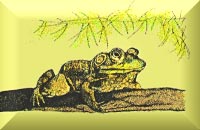|
|
|
|
|
|
|
|
|
|
SPECIES SPOTLIGHT
on

Rana catesbeiana
| A.K.A. |
The American Bullfrog.
|
| DESCRIPTION COLORATION |
Coloration:
|
| SIZE |
6 to 6.5 inches in length. 2 ounces in weight. The male is larger than the female which is uncommon among frog species.
|
| HOME |
This animal was originally found in North America east of the Rockies. It's range has spread to the west coast of North America, the Caribbean Islands, and Europe. The Bullfrog has been imported into these new areas by man to be used as a food source.
|
| HABITAT |
Lakes, ponds, and swamps.
|
| LIFESTYLE |
The Bullfrog is a solitary species except during the breeding season. It is active both diurnally and nocturnally.
|
| PREDATORS |
Man uses the Bullfrog for food. It is the common source of Frogs' Legs.
|
| DEFENSES |
This species will inflate with air to make itself look bigger. When grabbed by a predator, the Bullfrog may give a loud scream with the intent to frighten it's enemy.
|
| FOOD |
As a tadpole this animal eats algae, bacteria, and dead animals. Even as an adult this frog prefers to eat it's food underwater. It may capture it's prey above water, but it will often return to the water to eat it. Adults feed on fish, insects, small mammals, snails, worms, young birds, small snakes, and baby alligators. The Bullfrog is also cannibalistic.
|
| BREEDING |
Bullfrog breeding takes place in the spring or early summer. The male uses it's bull-like call to attract females and establish it's territory. The male fertilizes the eggs directly after the female lays them. 10,000 to 20,000 eggs are laid in a large egg mass that floats at the surface of the water. The eggs will hatch after 4 to 20 days. The male Bullfrog has sometimes been known to defend it's newly hatching tadpoles.
|
| METAMORPHOSIS |
1 to 3 years.
|
| LIFE SPAN |
15 years in nature. 8 months to a few years in captivity.
|
|
IN CAPTIVITY
|
It is suggested that Bullfrogs be provided with very large enclosures. Bullfrogs should have access to a pond-like water source. Sphagnum moss is a good substrate. The recommended temperature is between 65 and 75 degrees Fahrenheit. A captive Bullfrog may eat locusts, mice, young rats, and fish. Breeding in captivity is difficult. Captive tadpoles should be kept in water with a temperature ranging from 70 to 75 degrees Fahrenheit for maximum health and growth however, these tadpoles can survive in water of almost any reasonable temperature. The tadpoles will feed on algae and boiled lettuce.
|
| SPECIAL CONCERNS |
This animal is threatened by habitat destruction, acid rain, and polluted waters.
|
| INTERESTING FACTS |
The Bullfrogs is the largest frog in Michigan. |
|
For more info see: |
|